|
|
|
Sort Order |
|
|
|
Items / Page
|
|
|
|
|
|
|
| Srl | Item |
| 1 |
ID:
104330
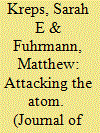

|
|
|
|
|
| Publication |
2011.
|
| Summary/Abstract |
What are the consequences of military strikes against nuclear facilities? In particular, do they 'work' by delaying the target states ability to build the bomb? This article addresses these questions by conducting an analysis of 16 attacks against nuclear facilities from 1942 to 2007. We analyze strikes that occurred during peacetime and raids that took place in the context of an ongoing interstate war. The findings indicate that strikes are neither as uniformly fruitless as the skeptics would suggest, nor as productive as advocates have claimed. There is evidence that the peacetime attacks delayed the target's nuclear program, although the size of this effect is rather modest. The wartime cases were less successful, as attacks often missed their targets either due to operational failure or limited intelligence on the location of critical targets. In our concluding section we show that many of the conditions that were conducive to past success are not present in the contemporary Iran case. Overall, our findings reveal an interesting paradox. The historical cases that have successfully delayed proliferation are those when the attacking state struck well before a nuclear threat was imminent. Yet, this also happens to be when strikes are the least legitimate under international law, meaning that attacking under these conditions is most likely to elicit international censure.
|
|
|
|
|
|
|
|
|
|
|
|
|
|
|
|
| 2 |
ID:
184242
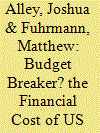

|
|
|
|
|
| Summary/Abstract |
How do alliance commitments affect US military spending? This question is at the heart of debates about the value of alliances and the future of US grand strategy. One perspective, which we call the budget hawk view, asserts that alliances are exorbitantly expensive, as they require military investments to deter third-party adversaries and reassure allies, encourage free riding, and facilitate reckless allied behavior. A competing view, which we label the bargain hunter perspective, claims that US alliance commitments are relatively cheap and might even reduce military spending. Allies provide key military capabilities, reassurance and extended deterrence are cheaper than they might initially seem, and alliances reduce the need for costly military interventions by promoting peace. Despite the importance of this debate, few studies have attempted to determine how alliance commitments affect US military spending. We use over-time variation in the number of US alliance commitments to estimate their financial toll. A statistical model of US defense expenditures from 1947 to 2019 shows that one new alliance commitment has a large positive association with defense budget levels in subsequent years. Military alliances benefit the United States in many ways but, consistent with the budget hawk view, they are expensive.
|
|
|
|
|
|
|
|
|
|
|
|
|
|
|
|
| 3 |
ID:
117997
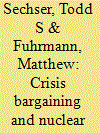

|
|
|
|
|
| Publication |
2013.
|
| Summary/Abstract |
Do nuclear weapons offer coercive advantages in international crisis bargaining? Almost seventy years into the nuclear age, we still lack a complete answer to this question. While scholars have devoted significant attention to questions about nuclear deterrence, we know comparatively little about whether nuclear weapons can help compel states to change their behavior. This study argues that, despite their extraordinary power, nuclear weapons are uniquely poor instruments of compellence. Compellent threats are more likely to be effective under two conditions: first, if a challenger can credibly threaten to seize the item in dispute; and second, if enacting the threat would entail few costs to the challenger. Nuclear weapons, however, meet neither of these conditions. They are neither useful tools of conquest nor low-cost tools of punishment. Using a new dataset of more than 200 militarized compellent threats from 1918 to 2001, we find strong support for our theory: compellent threats from nuclear states are no more likely to succeed, even after accounting for possible selection effects in the data. While nuclear weapons may carry coercive weight as instruments of deterrence, it appears that these effects do not extend to compellence.
|
|
|
|
|
|
|
|
|
|
|
|
|
|
|
|
| 4 |
ID:
113751
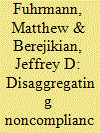

|
|
|
|
|
| Publication |
2012.
|
| Summary/Abstract |
Why do states make disingenuous treaty commitments? Under what conditions will countries refrain from entering cooperative agreements with which they do not expect to comply? This article addresses these questions by analyzing how states that are pursuing nuclear weapons treat the nuclear Nonproliferation Treaty (NPT). The authors develop a distinction between two types of noncooperative behavior. The first is cheating while part of the NPT (predation) and the second is pursuing nuclear weapons outside of the treaty (abstention). The authors' argument is that democratic proliferators are more likely to abstain because executives in democracies are domestically constrained to a greater degree than authoritarian leaders. Statistical tests in a sample of all countries with active nuclear weapons programs from 1968 to 2004 provide evidence in favor of our argument. Controlling for confounding variables and the factors that motivate states to pursue nuclear weapons, the results show that states with greater constraints on executive authority are less likely to choose predation. Yet, electoral mandates do not appear to dissuade governments from making disingenuous treaty commitments. These findings have important implications for nuclear proliferation, the credibility of international commitments, and efforts to link domestic political institutions with international outcomes.
|
|
|
|
|
|
|
|
|
|
|
|
|
|
|
|
| 5 |
ID:
153608
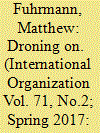

|
|
|
|
|
| Summary/Abstract |
Unmanned Aerial Vehicles (UAVs), more popularly known as “drones,” have become emblematic of twenty-first century military technologies but scholars have yet to convincingly explain the drivers of UAV proliferation. Using the first systematic data set of UAV proliferation, this research note examines the spread of UAVs in the context of scholarly debates about interests versus capacity in explaining policy adoption. The results yield important insights for both IR scholarship and the policy-making community. While countries that experience security threats—including territorial disputes and terrorism—are more likely to seek UAVs, drone proliferation is not simply a function of the threat environment. We find evidence that democracies and autocracies are more likely than mixed regimes to develop armed UAV programs, and suggest that autocracies and democracies have their own unique incentives to acquire this technology. Moreover, supply-side factors play a role in the UAV proliferation process: a state's technological capacity is a strong predictor of whether it will obtain the most sophisticated UAVs. The theories and evidence we present challenge emerging views about UAV proliferation and shed useful light on how and why drones spread.
|
|
|
|
|
|
|
|
|
|
|
|
|
|
|
|
| 6 |
ID:
083474
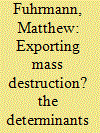

|
|
|
|
|
| Publication |
2008.
|
| Summary/Abstract |
This study applies well-known arguments on the effect of conflict, alliances, and democracy on international trade to identify the determinants of dual-use trade. Dual-use commodities are those that can be used in weapons of mass destruction (WMD) programs or in legitimate civilian applications. This article advances a theory suggesting that governments seeking to maximize the gains from dual-use trade will promote exports to countries where there are security guarantees and restrict exports to countries where security threats exist. Eight hypotheses are tested using data on licensed dual-use exports from the United States to 128 countries between 1991 and 2001. The results indicate that democracy has a positive and significant effect on dual-use exports, while WMD acquisition or pursuit does not necessarily reduce states' access to such commodities. The results vary slightly, based on how dual-use exports are measured. In conducting the first systematic analysis on the determinants of dual-use trade, this study contributes to scholarly understanding of WMD proliferation and research at the nexus of international trade and international security. In particular, it offers important prescriptions for when states are likely to transfer technology that could be used to build WMD. It also encourages further work that disaggregates trade data to examine relationships between particular types of trade and conflict, alliances, free trade agreements, and other political variables
|
|
|
|
|
|
|
|
|
|
|
|
|
|
|
|
| 7 |
ID:
081309


|
|
|
|
|
| Publication |
2008.
|
| Summary/Abstract |
In September 1991, U.S. President George H.W. Bush launched the Presidential Nuclear Initiatives (PNIs), which were unilateral measures that led to the largest reductions in the American and Soviet/Russian nuclear arsenals to date. Despite their eventual success, the United States took on significant risks in launching the PNIs. To uncover the best theoretical explanation for their onset, this article uses realism, neorealism, the bureaucratic politics model, expected utility theory, and prospect theory to generate ex ante predictions regarding nuclear arms control at the end of the Cold War. It then tests the theories' predictions against the empirical record. The results suggest that a focus on an individual decision maker-President Bush-is necessary to fully understand the PNIs and that an explanation rooted in prospect theory offers the most explanatory power. This study speaks to an important debate in discipline regarding the significance of individuals, while underscoring the value of exploring foreign policy decision making from multiple levels of analysis. It also advances the literatures on risk acceptance and prospect theory by shifting their applications away from militarized conflict and crises to diplomatic negotiations and cooperation
|
|
|
|
|
|
|
|
|
|
|
|
|
|
|
|
| 8 |
ID:
131239
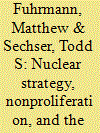

|
|
|
|
|
| Publication |
2014.
|
| Summary/Abstract |
Why do countries deploy nuclear weapons abroad? Since 1945, more than twenty states have hosted foreign nuclear weapons on their territory, and five countries continue to do so today. These deployments have important consequences for international security, yet there is little systematic research about the factors that drive them. In this article, we develop three broad theoretical frameworks to explain why foreign nuclear deployments occur. Using a new data set of foreign nuclear deployments between 1945 and 2000, we find that two factors weigh heavily in driving these deployments: the protection of allies and the projection of military power. Nonproliferation motives, however, appear to play little role. The results carry important implications for our understanding of the causes of proliferation and the sources of nuclear posture.
|
|
|
|
|
|
|
|
|
|
|
|
|
|
|
|
| 9 |
ID:
158520
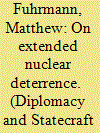

|
|
|
|
|
| Summary/Abstract |
This analysis discusses the central challenges that countries face when they practice extended nuclear deterrence. One key problem has to do with credibility: potential aggressors may not believe that a country would fight to defend an ally, particularly if doing so risks a nuclear attack against its homeland. Countries might be able to address this issue by forging formal alliances with protégés or by stationing nuclear forces on the protégé’s territory. Do these measures discourage third-party aggression? Defence pacts involving nuclear-armed states effectively bolster extended deterrence. One risk of extending nuclear protection from the American perspective, however, is that it might pull the United States into unwanted wars by risk-acceptant protégés. Yet, in a nuclear context, the risk of alliance entrapment is generally overblown. Placing nuclear weapons on an ally’s territory does much less to bolster extended deterrence than one might initially think. Although foreign nuclear deployments may reassure allies and promote non-proliferation to some degree, their value for extended deterrence is fairly minimal. The United States continues to deploy nuclear weapons in five European countries, but the case for maintaining these deployments is decidedly weak.
|
|
|
|
|
|
|
|
|
|
|
|
|
|
|
|
| 10 |
ID:
149251


|
|
|
|
|
| Summary/Abstract |
What are the consequences of drone proliferation for international security? Despite extensive discussions in the policy world concerning drone strikes for counterterrorism purposes, myths about the capabilities and implications of current-generation drones often outstrip reality. Understanding the impact of drones requires separating fact from fiction by examining their effects in six different contexts—counterterrorism, interstate conflict, crisis onset and deterrence, coercive diplomacy, domestic control and repression, and use by nonstate actors for the purposes of terrorism. Although current-generation drones introduce some unique capabilities into conflicts, they are unlikely to produce the dire consequences that some analysts fear. In particular, drone proliferation carries potentially significant consequences for counterterrorism operations and domestic control in authoritarian regimes. Drones could also enhance monitoring in disputed territories, potentially leading to greater stability. Given their technical limitations, however, current-generation drones are unlikely to have a large impact on interstate warfare. Assessing the consequences of drone proliferation has important implications for a range of policy issues, including the management of regional disputes, the regulation of drone exports, and defense against potential terrorist attacks on the homeland.
|
|
|
|
|
|
|
|
|
|
|
|
|
|
|
|
| 11 |
ID:
090985
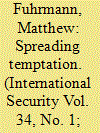

|
|
|
|
|
| Publication |
2009.
|
| Summary/Abstract |
Peaceful nuclear cooperation-the transfer of nuclear technology, materials, or know-how from one state to another for peaceful purposes-leads to the spread of nuclear weapons. In particular, countries that receive peaceful nuclear assistance are more likely to initiate weapons programs and successfully develop the bomb, especially when they are also faced with security threats. Statistical analysis based on a new data set of more than 2,000 bilateral civilian nuclear cooperation agreements signed from 1950 to 2000 lends strong support for this argument. Brief case studies of the Indian and Pakistani nuclear weapons programs provide further evidence of the links between peaceful nuclear assistance and proliferation. The finding that supplier countries inadvertently raise the risks of nuclear proliferation poses challenges to the conventional wisdom. Indeed, the relationship between civilian nuclear cooperation and proliferation is surprisingly broad. Even assistance that is often viewed as innocuous, such as training nuclear scientists or providing research or power reactors, increases the likelihood that nuclear weapons will spread. "Proliferation-proof" nuclear assistance does not exist. With a renaissance in nuclear power on the horizon, major suppliers, including the United States, should reconsider their willingness to assist other countries in developing peaceful nuclear programs.
|
|
|
|
|
|
|
|
|
|
|
|
|
|
|
|
| 12 |
ID:
091418
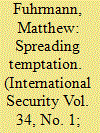

|
|
|
|
|
| Publication |
2009.
|
| Summary/Abstract |
Peaceful nuclear cooperation-the transfer of nuclear technology, materials, or know-how from one state to another for peaceful purposes-leads to the spread of nuclear weapons. In particular, countries that receive peaceful nuclear assistance are more likely to initiate weapons programs and successfully develop the bomb, especially when they are also faced with security threats. Statistical analysis based on a new data set of more than 2,000 bilateral civilian nuclear cooperation agreements signed from 1950 to 2000 lends strong support for this argument. Brief case studies of the Indian and Pakistani nuclear weapons programs provide further evidence of the links between peaceful nuclear assistance and proliferation.
|
|
|
|
|
|
|
|
|
|
|
|
|
|
|
|
| 13 |
ID:
087445


|
|
|
|
|
| Publication |
2009.
|
| Summary/Abstract |
When and why do states transfer nuclear technology, materials, and knowledge to other states for peaceful purposes? This question is important given the recent finding that countries receiving nuclear aid are more likely to pursue and acquire nuclear weapons. I argue that countries provide civil nuclear assistance for three strategic reasons: to strengthen their allies and alliances, to strengthen their relationship with enemies of enemies, and to strengthen existing democracies and bilateral relationships with these countries (if the supplier is also a democracy). I test these arguments using statistical analysis and a new data set on more than 2,000 bilateral civilian nuclear cooperation agreements signed between 1950 and 2000. The findings offer robust empirical support for my argument and very little support for the competing explanation rooted in norms and nonproliferation. This article enhances scholarly understanding of how and why nuclear weapons spread and encourages further research on the supply side of nuclear proliferation. It also has broad implications for the literatures on norms and international cooperation.
|
|
|
|
|
|
|
|
|
|
|
|
|
|
|
|
| 14 |
ID:
101681
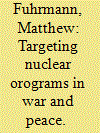

|
|
|
|
|
| Publication |
2010.
|
| Summary/Abstract |
When do states attack or consider attacking nuclear infrastructure in nonnuclear weapons states? Despite the importance of this question, relatively little scholarly research has considered when and why countries target nuclear programs. The authors argue that states are likely to attack or consider attacking nuclear facilities when they are highly threatened by a particular country's acquisition of nuclear weapons. Three factors increase the salience of the proliferation threat: (1) prior violent militarized conflict; (2) the presence of a highly autocratic proliferator; and (3) divergent foreign policy interests. The authors test these propositions using statistical analysis and a new data set on all instances when countries have struck or seriously considered striking other states' nuclear infrastructure between 1941 and 2000. The findings lend support for the theory and very little support for the alternative explanations. States are not deterred from attacking nuclear programs by the prospect of a military retaliation and concerns about international condemnation do not appear to influence the willingness to strike. Ultimately, states are willing to accept substantial costs in attacking if they believe that a particular country's acquisition of nuclear weapons poses a significant threat to their security.
|
|
|
|
|
|
|
|
|
|
|
|
|
|
|
|
| 15 |
ID:
162692
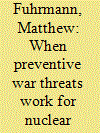

|
|
|
|
|
| Summary/Abstract |
On June 7, 1981, eight Israeli F-16 jets dropped bombs on an Iraqi nuclear reactor commonly known as Osiraq. The strike eliminated Iraq’s most critical nuclear facility before it was completed, thereby eroding Saddam Hussein’s capacity to make nuclear bombs. The Osiraq raid may be the most well-known preventive attack in the name of nonproliferation, but it is hardly the only time that countries have targeted nuclear materials or infrastructure militarily.
|
|
|
|
|
|
|
|
|
|
|
|
|
|
|
|
|
|
|
|
|